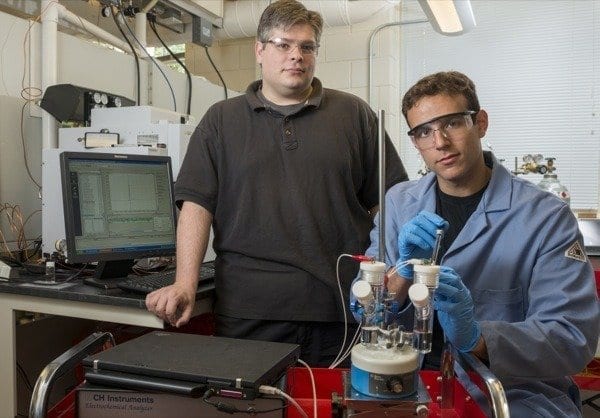
UD scientists pioneer inexpensive catalyst to drive synthetic fuel production
University of Delaware chemist Joel Rosenthal is driven to succeed in the renewable energy arena.
Working in his lab in UD’s Department of Chemistry and Biochemistry, Rosenthal and doctoral student John DiMeglio have developed an inexpensive catalyst that uses the electricity generated from solar energy to convert carbon dioxide, a major greenhouse gas, into synthetic fuels for powering cars, homes and businesses.
The research is published in the June 19 issue of the Journal of the American Chemical Society.
Gold and silver represent the “gold standard” in the world of electrocatalysts for conversion of carbon dioxide to carbon monoxide. But Rosenthal and his research team have pioneered the development of a much cheaper alternative to these pricey, precious metals. It’s bismuth, a silvery metal with a pink hue that’s a key ingredient in Pepto-Bismol, the famous pink elixir for settling an upset stomach.
An ounce of bismuth is 50 to 100 times cheaper than an ounce of silver, and 2,000 times cheaper than an ounce of gold, Rosenthal says. Bismuth is more plentiful than gold and silver, it is well distributed globally and is a byproduct in the refining of lead, tin and copper.
Moreover, Rosenthal says his UD-patented catalyst offers other important advantages: selectivity and efficiency in converting carbon dioxide to fuel.
“Most catalysts do not selectively make one compound when combined with carbon dioxide — they make a whole slew,” Rosenthal explains. “Our goal was to develop a catalyst that was extremely selective in producing carbon monoxide and to power the reaction using solar energy.”
Many of us hear ‘”carbon monoxide” and think “poison.”
“It’s true that you do not want to be in a closed room with carbon monoxide,” Rosenthal says. “But carbon monoxide is very valuable as a commodity chemical because it’s extremely energy rich and has many uses.”
Carbon monoxide is used industrially in the water-gas shift reaction to make hydrogen gas. It also is a prime feedstock for the Fischer-Tropsch process, which allows for the production of synthetic petroleum, gasoline and diesel.
Commercial production of synthetic petroleum is under way or in development in a number of countries, including Australia and New Zealand, China and Japan, South Africa and Qatar.
Rosenthal says that if carbon dioxide emissions become taxed in the future due to continuing concerns about global warming, his solar-driven catalyst for making synthetic fuel will compete even better economically with fossil fuels.
“This catalyst is a critically important linchpin,” Rosenthal says. “Using solar energy to drive the production of liquid fuels such as gasoline from CO2 is one of the holy grails in renewable energy research. In order to do this on a practical scale, inexpensive catalysts that can convert carbon dioxide to energy-rich compounds are needed. Our discovery is important in this regard, and demonstrates that development of new catalysts and materials can solve this problem. Chemists have a big role to play in this area.”
The Latest Bing News on:
Synthetic fuel production
- Synthetic Natural Gas Market worth $68.4 billion | MarketsandMarkets™on May 9, 2024 at 3:00 am
Synthetic Natural Gas Market in terms of revenue was estimated to be worth $23.9 billion in 2024 and is poised to reach $68.4 billion by 2029, growing at a CAGR of 23.4% from 2024 to 2029 according to ...
- United against plastic? Easier said than doneon May 9, 2024 at 1:48 am
In a 2020 study I co-authored, my colleagues and I found that primary plastic production -- the creation of new synthetic polymers, largely from fossil fuel -- will need to be 47% lower in 2040 ...
- Reinvent oil refineries for a net-zero futureon May 8, 2024 at 8:01 am
They convert crude oil into liquid fuels used in transportation, notably diesel, petrol and jet fuel. Refineries also provide chemicals and synthetic materials that ... suggest that alternatives to ...
- A global plastic treaty will only work if it caps production, modeling showson May 6, 2024 at 9:11 am
An international agreement to end plastic pollution is due to be sealed this year in Busan, South Korea. At the penultimate round of negotiations, held in Ottawa, Canada, Rwanda and Peru proposed a ...
- 2024 Porsche Mobil 1 Supercup to switch to synthetic fuelon May 1, 2024 at 5:00 pm
Starting this year, Porsche will supply teams competing in the Porsche Mobil 1 Supercup series with synthetic fuel, also known as e-fuel. While carbon dioxide is emitted when the fuel is burned, the ...
- Porsche will run an entire race series using only synthetic fuelson May 1, 2024 at 6:15 am
Porsche is serious about proving that its synthetic fuel is a viable alternative to gasoline in an increasingly electrified world. The company announced all of the cars that will compete in the ...
- Breaking the Oil Habit: How Synthetic Bacteria Could Revolutionize Chemical Productionon April 29, 2024 at 10:28 pm
The chemical industry primarily depends on fossil resources like crude oil to manufacture a range of chemicals, including plastics, dyes, and synthetic flavors. “Globally, it consumes 500 million tons ...
- Here’s How Porsche’s Synthetic Fuel Could Be A Gamechanger In The Auto Industryon April 22, 2024 at 10:00 am
Porsche has been working on alternate fuels for quite some time, and here's why its development of synthetic fuels is a big deal.
- House Panel Says China Subsidizes Fentanyl Production to Fuel U.S. Crisison April 16, 2024 at 5:01 pm
Committee investigators said they accessed a government website that revealed tax rebates for the production of specific fentanyl precursors as well as other synthetic drugs as long as those ...
- House panel says China subsidizes fentanyl production to fuel crisis in the United Stateson April 16, 2024 at 5:01 pm
Committee investigators said they accessed a government website that revealed tax rebates for the production of specific fentanyl precursors as well as other synthetic drugs as long as those ...
The Latest Google Headlines on:
Synthetic fuel production
[google_news title=”” keyword=”synthetic fuel production” num_posts=”10″ blurb_length=”0″ show_thumb=”left”]
The Latest Bing News on:
Synthetic fuel
- Occidental Petroleum’s net-zero strategy is a ‘license to pollute,’ critics sayon May 9, 2024 at 1:31 am
What we have to do is phase out fossil fuels, not perpetuate their life.” Oxy first outlined its net-zero strategy in 2020, making it the first American oil major to do so. Today, Oxy describes that ...
- Sustainable Fuel Market Soars From $350.44M To $15.74B By 2030, Fueled By 60.9% CAGR And Dynamic Growth Driverson May 8, 2024 at 10:52 pm
Although, Africa and South America are expected to witness slower growth due to underdeveloped infrastructure and a lack of strong regulatory frameworks. Despite the regional variations, the global ...
- Reinvent oil refineries for a net-zero futureon May 8, 2024 at 8:01 am
They convert crude oil into liquid fuels used in transportation, notably diesel, petrol and jet fuel. Refineries also provide chemicals and synthetic materials that are used to produce most of today’s ...
- Synthetic Fuel Drops Horsepower and Torque Slightlyon May 8, 2024 at 5:59 am
Evo compared the manufacturer-provided torque and horsepower to that of a dyno run with regular pump gas and then to the synthetically produced bio ...
- The first e-fuel in history that you can use in your car: U.S. to produce 1 billion literson May 5, 2024 at 5:00 am
America has created the first e-fuel in history that you can use now in your car: we will create 1 billion liters from this ...
- Drug supply, lack of recovery resources fuel fentanyl epidemicon May 3, 2024 at 5:01 pm
After all, Cheyenne sits at the intersection of two major interstates, and the north-south route offers a direct pipeline from Mexico, the source of much of the nation’s supply of the highly potent ...
- Shining a light on energy sustainability with synthetic methaneon May 1, 2024 at 10:43 pm
By producing synthetic methane using the sun, this team of researchers is working towards closing the carbon loop.Methane, the main ...
- 2024 Porsche Mobil 1 Supercup to switch to synthetic fuelon May 1, 2024 at 5:00 pm
Starting this year, Porsche will supply teams competing in the Porsche Mobil 1 Supercup series with synthetic fuel, also known as e-fuel. While carbon dioxide is emitted when the fuel is burned, the ...
- Porsche will run an entire race series using only synthetic fuelson May 1, 2024 at 6:15 am
Porsche is serious about proving that its synthetic fuel is a viable alternative to gasoline in an increasingly electrified world. The company announced all of the cars that will compete in the ...
- Porsche’s Supercup Series To Run On Synthetic eFuels This Yearon May 1, 2024 at 3:29 am
This year’s Porsche Mobil 1 Supercup season will run as a support program at eight Formula 1 events in Europe. The season will start on May 19 at the Grand Prix of Emilia-Romagna and end at the ...
The Latest Google Headlines on:
Synthetic fuel
[google_news title=”” keyword=”synthetic fuel” num_posts=”10″ blurb_length=”0″ show_thumb=”left”]











